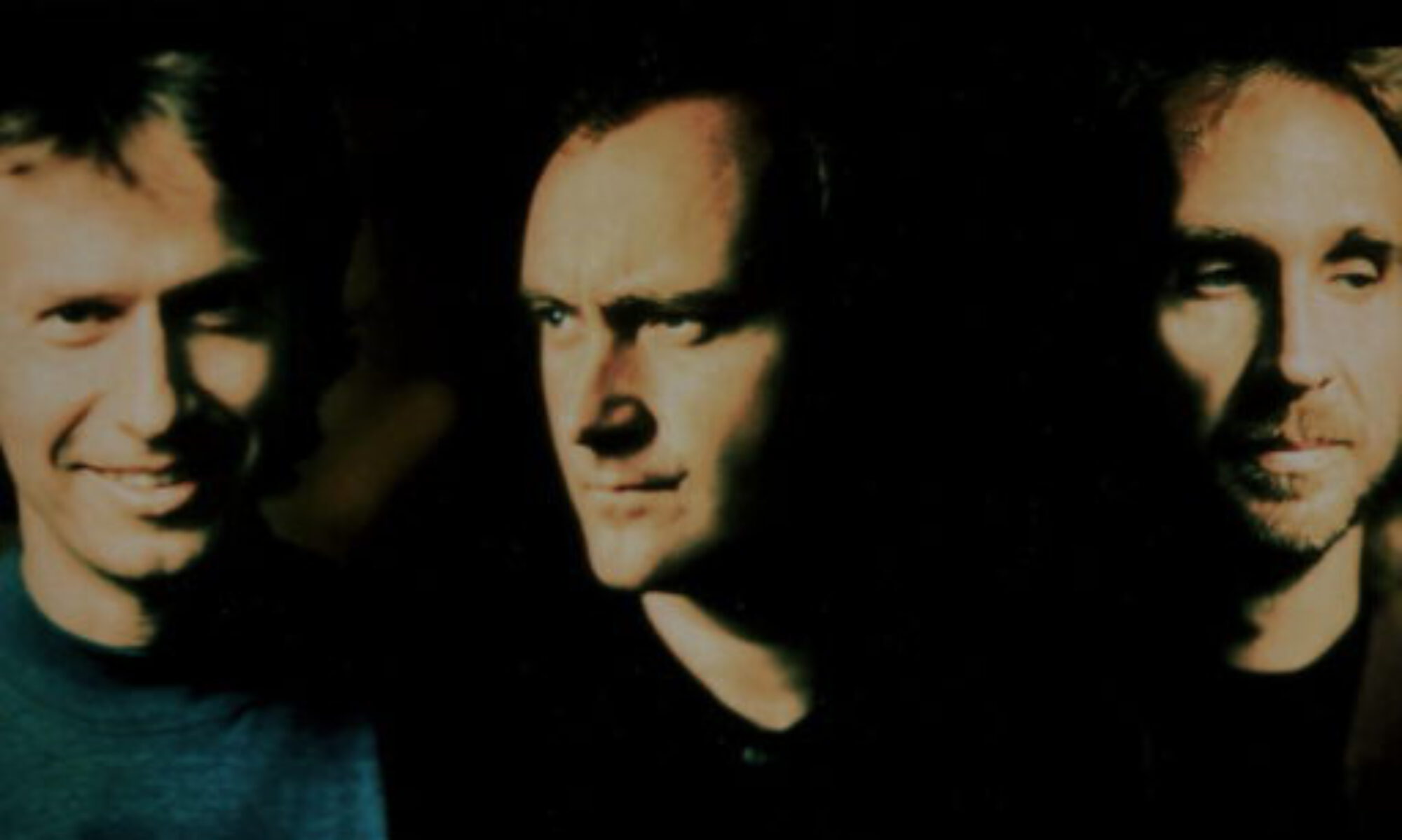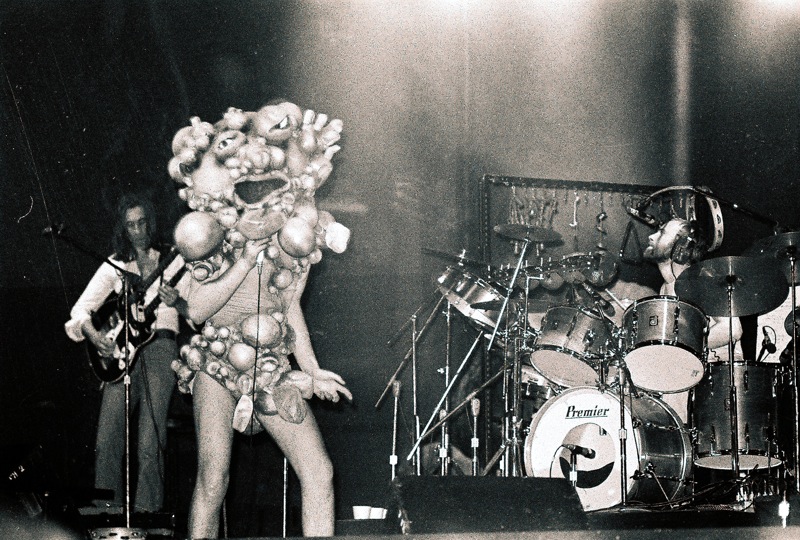As Genesis embarked on their ambitious The Lamb Lies Down on Broadway tour, which commenced on November 20, 1974, audiences were drawn into an elaborate fusion of music and visual storytelling that spanned 102 shows across the U.S., Europe, and the UK. The tour, running until May 22, 1975, was an unprecedented venture, marked by its innovation, chaos, and lasting legacy. But how did it become one of the most memorable and challenging chapters in Genesis’ history?
The Stage Spectacle: Multimedia and Costumes
To bring The Lamb to life on stage, Genesis crafted an elaborate production that featured three projection screens displaying 1,450 slides through seven projectors, showcasing images to match the surreal story of Rael, the central character. This visual experience aimed to immerse audiences fully but proved temperamental—working seamlessly on only a handful of nights. Tony Banks especially liked the beginning showing the New York skyline and making it seem as if the band played there. However, technical issues often plagued the show. The projectors rarely worked properly and often the images stuck, causing disruptions that frustrated both the band and the audience.
Mike Rutherford mentioned the Chicago show as a rare instance when everything fell into place: “It was such a multimedia event…the music, it was just an assault on the senses.”1 But these perfect moments were few and far between, and the strain of performing an unfamiliar, double album took its toll. “At the time, when we first presented it, it was just a bunch of unfamiliar material,” Peter Gabriel admitted, “It wasn’t something that instantly brought the house down.”2
Peter Gabriel’s costumes also became a focal point. While Rael required just a leather jacket and makeup, Gabriel’s more outlandish costumes stole the spotlight. The most memorable was the Slipperman suit, described by road manager Richard MacPhail as resembling “inflated condoms,”3 out of which Gabriel would emerge from a tube during the performance—a scene intended to evoke rebirth. Unfortunately, the costume was so cumbersome that Gabriel struggled to sing into the microphone, impacting the performance. Phil Collins humorously described the Slipperman costume: “What’s happening? ‘I’m not sure, it’s a lot of strange stuff, but there’s Pete coming through a giant cock,’”4 highlighting both the spectacle and absurdity.
Explosions and Mishaps
The tour had its share of dramatic failures. During the climactic song “it,” the show included a small explosion and a flash. On one occasion, the production manager accidentally caused a huge explosion, prompting Phil Collins to famously shout, “You’re fired!” as stunned concertgoers quietly exited the venue.
Even more bizarre was the tour’s final night in Besançon, France. Instead of a mannequin, Tony Banks’s keyboard tech, Geoff Banks, appeared on stage naked, wearing only a leather jacket, playing with the audience’s perception of reality under strobe lights.
Internal Struggles and Peter’s Departure
The tour’s demands strained the band’s unity. Early into the U.S. leg, Gabriel told manager Tony Smith he intended to leave Genesis. Although Smith convinced him to finish the tour, tensions simmered.
Steve Hackett reflected on Gabriel’s decision: “I tried to convince him to stay. I love him, still do. Of course, this was just the beginning for Pete… I’ve got huge respect for his orientation towards world music and the association with WOMAD.”5 The public and critics alike focused on Gabriel’s theatrics, overshadowing the band’s musicianship and collaborative efforts. Tony Banks, although saddened, noted the shift: “Pete was also getting too big for the group…it was a very difficult thing to accommodate.”6 The spotlight that had once been shared now gravitated more towards Gabriel, creating an imbalance that was hard to reconcile.
Phil Collins was often seen as the pragmatic anchor amidst the chaos, even clarifying later misunderstandings about his feelings toward Gabriel’s theatrics: “If I could have rewritten the story, Pete would still have been in the band, and I would have stayed on the drums…the world would never have heard of Phil Collins as a solo artist.”7
The band’s fatigue was palpable. Each night required the performance of the full double album, challenging them with minimal room for improvisation. Some pieces, like “Fly on a Windshield” and “The Waiting Room,” allowed for brief departures from the script, moments cherished by both the band and their fans. Yet, Tony Banks expressed frustration at how certain songs, like “The Lamia” and “Anyway,” failed to capture the studio’s magic, limited by an electric piano rather than the grand piano used during recording.
The Final Curtain Call
The Lamb tour left Genesis with significant debt, reportedly around £25,000. More impactful was the departure of their charismatic frontman. Peter Gabriel’s farewell performance in Besançon was marked by a poignant moment backstage, where he played “The Last Post” on the oboe before stepping on stage one final time. Unaware until the last minute that this would be their final performance with Gabriel, the band pushed forward.
Reflecting on Gabriel’s exit, Mike Rutherford observed that, like Anthony Phillips’ departure years earlier, it reshaped the group:“When someone leaves like Anthony and Peter, there’s a sadness because you know you’ll never be as close again. You stay in touch, but you lose that bond of sharing things.”8 While fans and the media predicted doom, Gabriel himself had faith in his former bandmates’ songwriting capabilities, a belief that proved correct as Genesis evolved in the years that followed.
The The Lamb Lies Down on Broadway tour, despite its challenges and the eventual departure of Peter Gabriel, remains a testament to Genesis’ bold vision and resilience. It set the stage for both Gabriel’s solo success and Genesis’ evolution, proving that the end of one chapter was just the beginning of another.
How would Genesis recover from losing their iconic frontman? That was a story yet to unfold.
Title photo: Genesis live 1974-11-20. Wikimedia Commons, own work. Author: tony morelli / CC-BY-SA-2.5 (https://creativecommons.org/licenses/by/3.0).
Sources
Banks, Tony; Collins, Phil; Gabriel, Peter; Hackett, Steve; Rutherford, Mike; Dodd, Philip (2007): Genesis. Chapter & verse. New York: Thomas Dunne Books/St. Martin’s Griffin.
GENESIS REUNION 2014: “THE LAMB LIES DOWN ON BROADWAY” – STEVE, PETER ,TONY, MIKE, PHIL.
MIKE RUTHERFORD UNFILTERED: GENESIS GUITARIST/COMPOSER IN CONVERSATION.
RICHARD MACPHAIL INTERVIEW Revised : GENESIS early years.
STEVE HACKETT FULL INTERVIEW- Revised : MY GENESIS YEARS.
Footnotes
- MIKE RUTHERFORD UNFILTERED: GENESIS GUITARIST/COMPOSER IN CONVERSATION. ↩︎
- GENESIS REUNION 2014: “THE LAMB LIES DOWN ON BROADWAY” – STEVE, PETER ,TONY, MIKE, PHIL. ↩︎
- RICHARD MACPHAIL INTERVIEW Revised : GENESIS early years. ↩︎
- GENESIS REUNION 2014: “THE LAMB LIES DOWN ON BROADWAY” – STEVE, PETER ,TONY, MIKE, PHIL. ↩︎
- STEVE HACKETT FULL INTERVIEW- Revised : MY GENESIS YEARS. ↩︎
- Banks 2007: 158. ↩︎
- GENESIS REUNION 2014: “THE LAMB LIES DOWN ON BROADWAY” – STEVE, PETER ,TONY, MIKE, PHIL. ↩︎
- MIKE RUTHERFORD UNFILTERED: GENESIS GUITARIST/COMPOSER IN CONVERSATION. ↩︎


One Reply to “The Lamb Lies Down on Broadway Tour: A Theatrical Odyssey (1974–1975)”